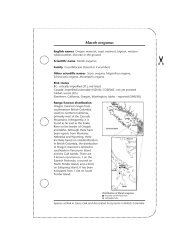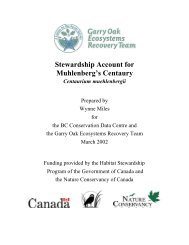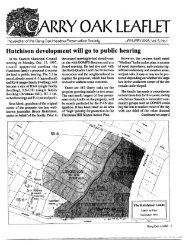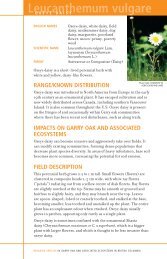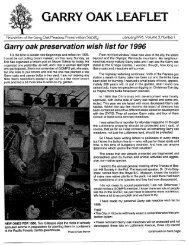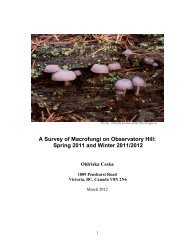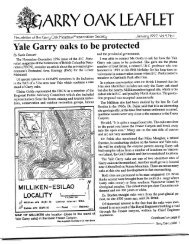A Survey of Macrofungi on Observatory Hill - Garry Oak Ecosystems ...
A Survey of Macrofungi on Observatory Hill - Garry Oak Ecosystems ...
A Survey of Macrofungi on Observatory Hill - Garry Oak Ecosystems ...
You also want an ePaper? Increase the reach of your titles
YUMPU automatically turns print PDFs into web optimized ePapers that Google loves.
O. Ceska - A <str<strong>on</strong>g>Survey</str<strong>on</strong>g> <str<strong>on</strong>g>of</str<strong>on</strong>g> Macr<str<strong>on</strong>g>of</str<strong>on</strong>g>ungi <strong>on</strong> <strong>Observatory</strong> <strong>Hill</strong>:<br />
Fall 2009 and Winter 2009/2010<br />
In my survey, I followed the Intuitive C<strong>on</strong>trolled <str<strong>on</strong>g>Survey</str<strong>on</strong>g> Method as described by the<br />
United States Bureau <str<strong>on</strong>g>of</str<strong>on</strong>g> Land Management in their numerous survey manuals.<br />
The methodology <str<strong>on</strong>g>of</str<strong>on</strong>g> mycological surveys was described in Roberts et al. (2004) and<br />
also in Castellano et al. (1999).<br />
Voucher specimens for most <str<strong>on</strong>g>of</str<strong>on</strong>g> the species collected <strong>on</strong> the site were preserved and<br />
will be deposited in the University <str<strong>on</strong>g>of</str<strong>on</strong>g> British Columbia Herbarium in Vancouver,<br />
BC. Representative specimens were photographed in the field.<br />
There is general misunderstanding that macr<str<strong>on</strong>g>of</str<strong>on</strong>g>ungi can be easily identified using<br />
macro characteristics al<strong>on</strong>e with the help <str<strong>on</strong>g>of</str<strong>on</strong>g> field guides. In fact, proper identificati<strong>on</strong><br />
requires a compound microscope and appropriate tax<strong>on</strong>omic literature with good<br />
keys. In some cases, specialized m<strong>on</strong>ographs that deal with <strong>on</strong>ly <strong>on</strong>e genus are<br />
necessary for reliable identificati<strong>on</strong>. According to Castellano et. al. (1999, p. M10)<br />
“three to four days <str<strong>on</strong>g>of</str<strong>on</strong>g> lab work should be anticipated for each successful day <str<strong>on</strong>g>of</str<strong>on</strong>g> field<br />
work.” Our experience from this survey and other surveys shows that this statement<br />
is well justified.<br />
Climate in the year 2010<br />
It is well known that fungi fructificati<strong>on</strong> depends <strong>on</strong> moisture and temperature. All<br />
fungi need moisture but temperature requirements can be different for different<br />
species. The majority <str<strong>on</strong>g>of</str<strong>on</strong>g> them need warm rather than cold temperatures, but many<br />
fungi require a drop in temperature to trigger their fructificati<strong>on</strong>.<br />
During the summer m<strong>on</strong>ths, there is no substantial amount <str<strong>on</strong>g>of</str<strong>on</strong>g> precipitati<strong>on</strong> in the<br />
Victoria area. However, in some years there is unusually high precipitati<strong>on</strong> during<br />
the summer m<strong>on</strong>ths that results in large number <str<strong>on</strong>g>of</str<strong>on</strong>g> fungal species. This anomaly can<br />
also trigger the occurrence <str<strong>on</strong>g>of</str<strong>on</strong>g> the late summer and early autumn species that do not<br />
occur in the “normal” years with dry summers. One such unusual summer was that <str<strong>on</strong>g>of</str<strong>on</strong>g><br />
2004. This was our first year <str<strong>on</strong>g>of</str<strong>on</strong>g> the <strong>Observatory</strong> <strong>Hill</strong> fungal survey; unfortunately,<br />
our survey started <strong>on</strong>ly at the end <str<strong>on</strong>g>of</str<strong>on</strong>g> November and we missed the peak <str<strong>on</strong>g>of</str<strong>on</strong>g> the fungal<br />
seas<strong>on</strong>.<br />
6




